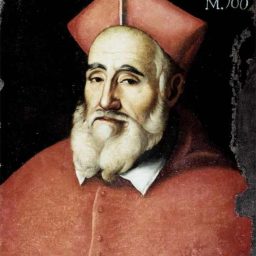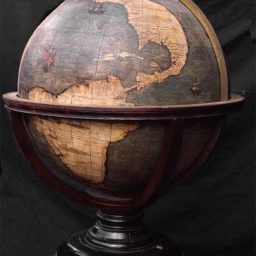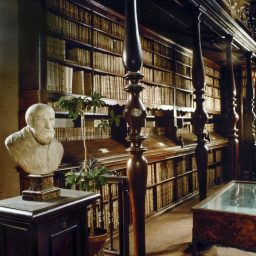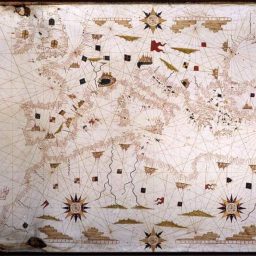The birth of Vallicelliana library is closely linked to the figure of Filippo Neri and the Congregation of oratory established in 1565 and officially recognized from Gregorio XIII with the bull “Copiosus in misericordia”. The oratorians had a particular focus on books: according to the rule the meals had to be accompanied by the reading and the discussion of a religious text.The first book collection is formed from works owned by Filippo Neri past into the heritage of the congregation at his death in 1595.The Vallicelliana library is already documented in 1581 thanks to the testamentary bequest of Achille Stazio in favour of FillipoNeri and the congregation of oratory: 1700 printed volumes and 300 manuscripts.To the first two collections are subsequently added additional donations, which are the archive and part of San Giovanni in venere Library ( 1585); the library of the cardinal Silvio Antoniano, the books of Pierre Morin and those of the oratorian Giovenale Ancina, bishop of Saluzzo (1604); the manuscripts coming from S. eutizio, thanks to the intervention of the abbot Giacomo Crescenzi and the collection of the father Antonio Gallonio, the first biographer of Filippo Neri (1605).In the seventeenth century the phase of the greatest cultural activity of the oratorian community is bound to the publication of Annales Ecclesiastici of Cesare Baronio, of the underground Rome of Antonio Bosio edited by Father Antonio Severano and the spread of the musical oratory, form of spiritual entertainment favourite by Filippo Neri who considered music like a grabber fisherwoman) of souls. In 1607 at the death of the cardinal Cesare Baronio, a part of his library collection is inherited by the library of the congregation; in 1662 the fund of Virgilio Spada arrives formed from a collection of coins, minerals, majolica and curiosity.In 1669 the manuscript Fund - which consisted of 237 between Greek and Latin manuscripts - belonging to the Greek intellectual Leone Allacci, the keeper of the Vatican Library, passed to the Library. Later on, the legacy of the oratorian Fathers Odorico Rinaldi, Giacomo Laderchi, Giuseppe Bianchini, the heir of the scholar Giuseppe Bianchini, was integrated. During the French occupation of Rome (1797 – 1799) the Library, as happened in other places, was the victim of a serious theft: in 1810, 49 relics were lost and partially recovered during the years 1837 – 1838. In 1874, after the law of the suppression of the religious corporations, Vallicelliana turned into a Public Law Library; in 1876, the liquidator council of the ecclesiastical axis established to subdivide the congregation’s documents between the State Archive of Rome, the same congregation and the Library.In 1883 the Società Romana di Storia Patria found its headquarters among some Vallicelliana’s places. It was established in 1876 for the purpose of publishing documents concerning the history of Rome and its province.The decree, which linked the two institutes, entrusted the direction and the Library’s scientific management to the Società Romana di Storia Patria and the administrative management to a consegnee keeper, named by the Ministry.In 1946 the relationships between the two institutes, even if they kept a functional interdependence, were disciplined differently: the management of Vallicelliana’s funds got back to the Library, which was also entrusted with the bibliographical organization and the public fruition of the Società’s collection.After being managed by the Ministry of Public Education, the Library today is a peripheral institute of the Ministry of Culture and Tourism.
The Library has about 130,000 volumes: manuscripts, incunabula, printed matter and music, mainly works of historical-ecclesiastical, scholarly, patristic and theological nature, but also texts of philosophy (there are many ancient commentators of Aristotle), law, botany, astronomy, architecture and medicine. In the important collection of about 3,000 Latin, Greek and Oriental manuscripts, there are codes of great value and antiquity, such as the Alcuin Bible of the ninth century (ms B 6); a miniated Greek Gospel book from the 12th century (ms. B 133) and a valuable 16th century Book of Hours (Ms. A 45). The ancient printed background, with works between the sixteenth and nineteenth centuries, consists of about 40,000 volumes, preserved for the most part in the prestigious Salone Borromini and a small nucleus of incunabula. A considerable part of the ancient background is constituted by the XVI century editions; a specific feature is the collection of the works belonging to Filippo Neri preserved in the Libraria. In the ancient background there are also periodical publications and numerous tenders, edicts, printed notices, dating from the sixteenth and nineteenth centuries, mostly emanating from the Papal State or dating back to the Napoleonic period in Italy. The iconographic material of the Vallicelliana includes a valuable collection of engravings as well as an important background of photographs.
The modern acquisitions, monographs and periodicals are identified in respect of the cultural interests of the Library, in order to offer tools for in-depth study, updating and support for the study of the Institute’s historical background.The Vallicelliana Library promotes projects for the enhancement of its historical, artistic and bibliographic heritage and organizes a calendar of cultural initiatives, exhibitions, presentations, conferences, exhibitions, lectures, seminars, workshops and visits in the Borrominium Institute.Among the latest exhibitions we mention: “Fragile Size. On show 200 fragile works “made by the artists who have joined the Manifesto of Fragility inaugurated on 20 January 2018 and ended on 24 February 2018; “The shape of the card. Scratches, incisions, colors in the work of Paolo Gubinelli “inaugurated on April 26, 2018 and still in progress. The Institute adheres to projects of the Ministry of Cultural Heritage and Activities such as the next European Heritage Days (22 and 23 September 2018) and the Charter Sunday (14 October 2018).For more information about scheduled events and those already made in the past years, consult the Library website: www.vallicelliana.it
Events at Rome Art Week
2019
Free access
2018
Free access







